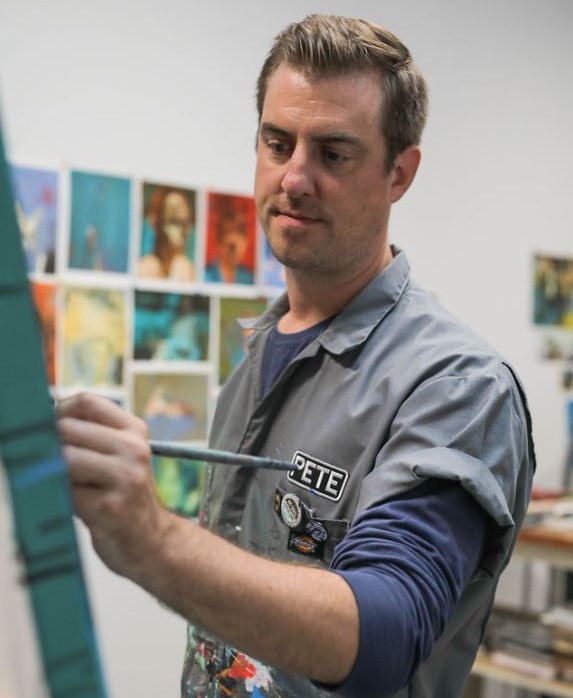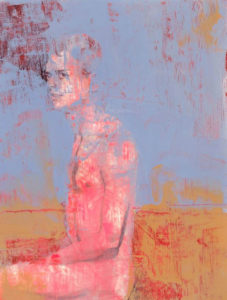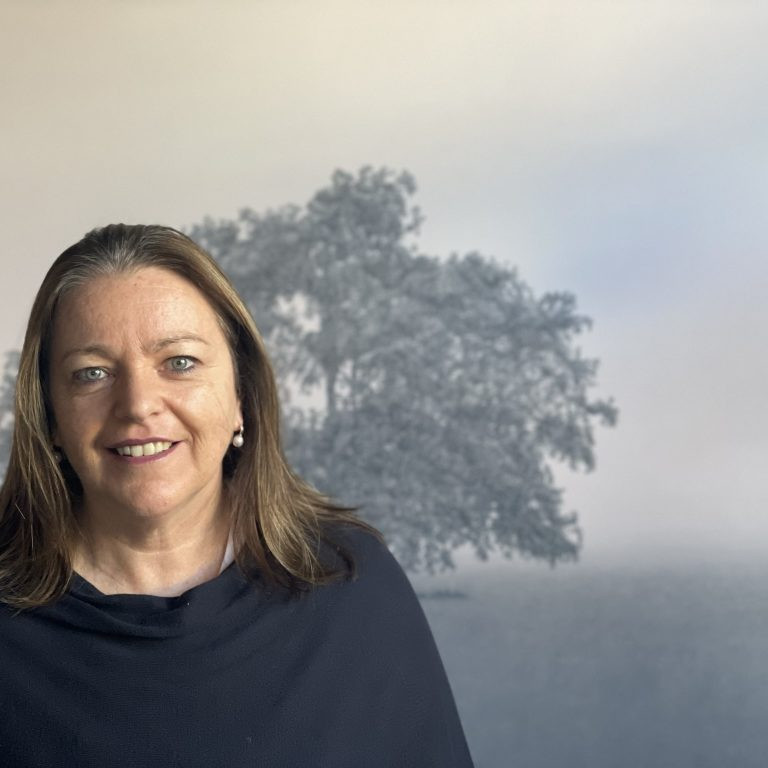Pete Sack Painter - North Carolina, USA
Pete Sack, North Carolina, USA
Sack shows and explains how he creates his images through his seven stage process…
Zoneone Arts brings Pete Sack to you…
Where do you source your original material from? Do you have copyrite issues with this?
My source material comes from personal photos, old college yearbooks and photos from magazines. I don’t concern myself with copyright issues. I just look at the images as a means to an end. I’m altering the original to the point of making it almost unrecognizable, or I’m just taking a portion of a face and combining it with another face.
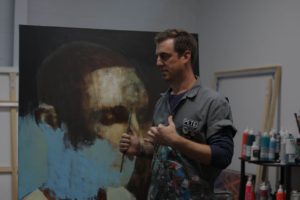
What is the technique you use in your art work?
Everything I do is on watercolour paper (140lb hot press). This is so I can create my watercolour base. I have done watercolour on canvas, it just takes so long to build up colour, so I opt for paper when I can. I buy rolls of watercolour paper for my large pieces and stretch them like canvas (after soaking it in a bath for 5-10 minutes). Once dry, I will paint a tightly rendered watercolour image, and then seal it with two coats of an acrylic gloss varnish to protect the painting. This coat also allows the oil paint to glide on a smooth surface.
I’ll add acrylic to block in shapes and again, to add another protective layer.
Oil paint is then used. This allows me to cover up, obscure and or glaze over the tightly rendered under painting with a loose, gestural application of paint. I enjoy the contrasting of mark making, allowing them their own time to shine on one piece of art.
Discuss the size of your work?
The size of my work varies. When I’m trying out new things or just need to paint something, I’ll work small (currently 11 inches x 8 inches). I can get these done in 2-3 hours and they are a fun way to be free, since I’m not devoting a lot of time into them. What comes from these studies can make their way into my larger work. Currently I am starting on a series that are larger (60 inches x 48 inches and 72 inches x 48 inches) and these will pull from the smaller experiments.
You state, ‘I paint a new painting every day’ discuss this aspect of your work.
This was a younger version of me, when I was pushing this new (for me) way of painting. The works were no bigger than a postcard, and for 2-3 years I created 800 pieces.
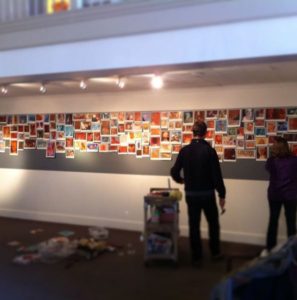
Most were pretty raw, just me getting comfortable with what I could get away with and how the paints would react and play with one another.
As I have gotten older, I have gotten more deliberate in what I am painting. So more thought goes into composition and colour combinations. Plus the size has gotten larger, so my one a day painting is now 3-4 a week for smaller works and 1 a week for the larger pieces. And I also have learned the value of taking breaks (months and weeks), to avoid burnout and recharge my energies.
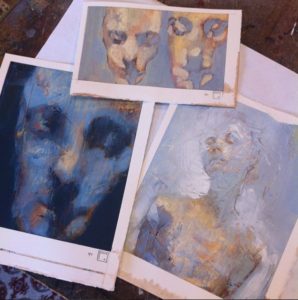
Discuss your movement from Watercolour to oil and now the combination.
The first painting medium I worked in with any proficiency was watercolours, when I was 12 or 13. I would paint baseball players all day long and unknowingly developed the skill of being able to paint a tightly rendered image quickly.
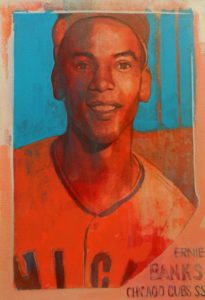
When I went to university, oil paint (and some acrylic) was king and therefore was all I used. I do remember one painting that I made in which I combined the two (watercolour and oil), but why I did that or which professor pushed that is lost on me.
My oil paint use went through my mid-twenties, but then something clicked and I restarted the combining of mediums. I like to paint fast, just get whatever I need out as quickly as possible, to avoid self-editing. So my wanting to paint a detailed portrait or figure and then add other elements of distortion just wasn’t possible with straight oil.
Can you discuss 2 works from your show at the Raleigh City Museum?
These pieces were part of a show that I had at the Raleigh City Museum, where they gave me access to their archived photos. There were hundreds of pictures to choose from, but the majority were dated from the 1940s-60s.
The photo of the boys swimming was of Chavis pool in Raleigh, which was the first integrated public pool in the city. I like the looks on all the swimmers faces, joyful and carefree, as summer should be.
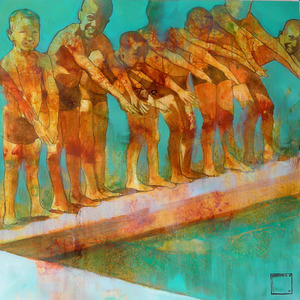
The other is a team photo of Shaw University women’s basketball team, which is a local Black university in Raleigh. This team went on to win their league championship, which was the reason for the photo.
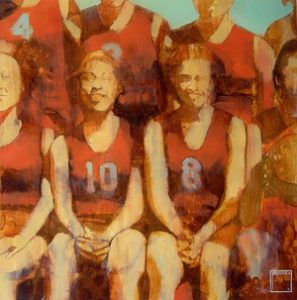
Expand on one of your close-up images.
I’ll show you a piece that I just completed, or at least is 99% done. It is 60 inches x 48 inches, stretched watercolour paper over stretcher bars.
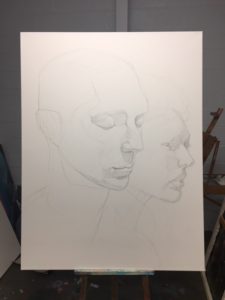
- Pencil drawing of the images I want to use.
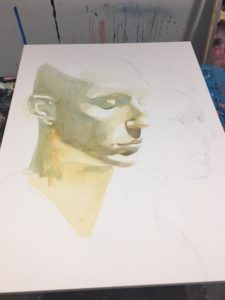
- The laying of watercolour paint. Because of the size, this took 2 days.
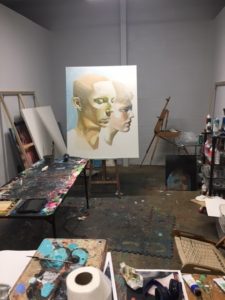
- Studio shot after day one of watercolour application.

- Watercolour done. I then applied two coats of acrylic gloss varnish and in this photo I applied a muted green acrylic colour to surround the figures.
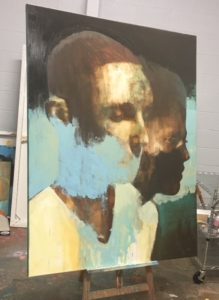
- The layering of oil paint starts. In this case I added a burnt umber over the whole piece and while away select portions. I find that oil paint reacts better to the paper on a thin (even wiped away) layer of oil.
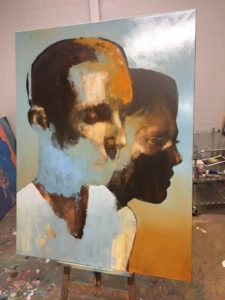
- At this point I’m just pushing colours and into the piece and seeing what sticks. Anything that doesn’t work I wipe off or paint over the next day.
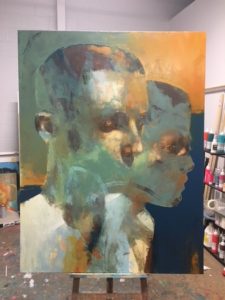
I hate to say I make it up as I go along, but it’s at this point that intuition takes over and I just know what is working and what isn’t. It can make for really “easy” paintings that tend to paint themselves, or really difficult ones that are a true labour. But if the foundation of an idea is sound and there’s enough to work with image wise, I like this struggle. Because once a painting clicks and comes together, it’s all worth it. And that sense of completion comes almost instantaneously, out of nowhere and you just know the work is done.
Discuss ‘Life on auto Pilot 1, 11, 111 expand on this.
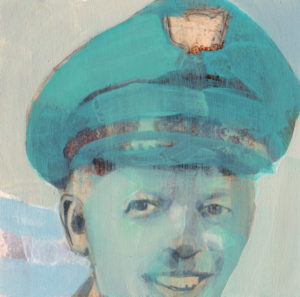
Once my thirties hit this sense of routine seeped into my life, as it happens to most people. Wake up, go to work, go to sleep and repeat. I’m not saying it’s a particular bad thing, (especially having a job that afforded me the luxury to paint, support and provide for me, etc.) it was just a moment when I was able to take a step back and reflect on this auto pilot haze makes life slip by faster. The days blend and are therefore marked by moments that get you out of the routine.
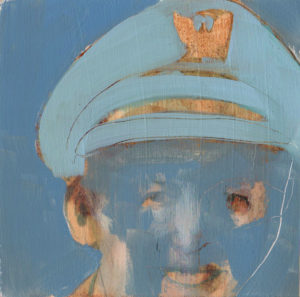
At this particular point, painting was the only real wild card that I had control over, in which I could change things up at a moment’s notice.
So I used that feeling of being on auto pilot to create a series that is very literal (a photo of a pilot) but also conveys the feeling of sameness mixed with a blurring and hazing of life.
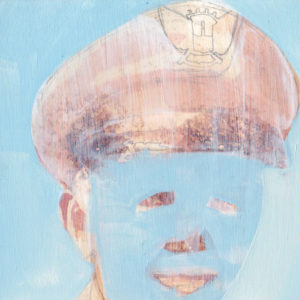
Comment on your signature. 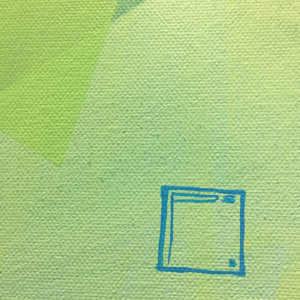
I’ve used my square box signature since 2001. The origin story is a little hazy, but it comes around the same time I visited Frank Lloyd Wright’s studio in Chicago. His work is so clean in line and intentional in thought.
I wanted a signature that wasn’t an afterthought, which also worked itself into the composition of the piece. Not to distract, but to help move the eye around by the shape and colour. I’m not a fan of artists not signing work or putting it on the back. My work is a part of me, so I’m going to put my stamp on it.
Do you take portrait commissions?
I used to, but now I only will do pet portrait commissions.
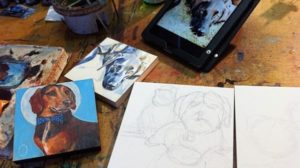
I’ve been doing portraits or paintings of faces for 25 years, so I’ve mentally moved on from having to recreate a portrait that bears any sort of likeness to an individual. It feel like homework and it comes across in the commission. So I don’t want to waste my time or the client’s.
Contact details:
Pete Sack
Instagram : petesack
Pete Sack, North Carolina, USA
Interview by Deborah Blakeley, October 2018
Think a colleague or friend could benefit from this interview?
Knowledge is one of the biggest assets in any business. So why not forward this on to your friends and colleagues so they too can start taking advantage of the insightful information the artist has given?
Other artists you may be interested in:


